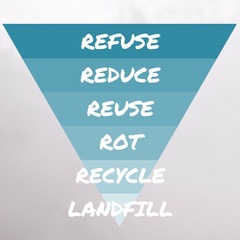An Update to the Three Rs
You are likely familiar with the slogan “reduce, reuse, recycle” that became popular in the late 1970’s. Of the three original Rs, recycling became the one we depended on to save us from the ever-increasing amount of largely plastic waste we were producing. But unfortunately, there is not much, if any, demand for many types of post-consumer plastics.
Author Bea Johnson, in Zero Waste Home: The Ultimate Guide to Simplifying Your Life by Reducing Your Waste suggested we adopt zero waste practices that interrupt the need for recycling, and the focus on a new and improved set of Rs began.
Here are the 5 Rs you can practice to reduce waste in your life and in your home. And they are listed in order of impact, so start at the top!
1. Refuse: Begin by refusing stuff that you do not need or that becomes waste immediately. Think about junk mail, single-use packaging, branded swag, and free things you really don’t need.
2. Reduce: Waste can be reduced by carefully considering what we need and want. This goes hand in hand with refusing. Also, buying items that will last or can be refilled may be more economical in the long run along with being better for the environment.
3. Reuse/Repurpose/Repair: Keeping things out of the landfill or ocean helps cut down on waste. By repairing items and finding new uses for things we already have, resources are conserved and used more efficiently.
4. Rot: Food and yard waste makes up a large part of what goes to the landfill. By composting vegetable, green waste like leaves, and yard trimmings, we can save landfill space and make compost for gardens. If composting isn’t an option, some local services may accept green waste.
5. Recycle: As the final option, anything that can be recycled should be. Donate used clothes, electronics, and household items to local thrift stores. Clean and sort cardboard, metals, and numbered plastics for recycling either at the curb or through a
local recycler.
